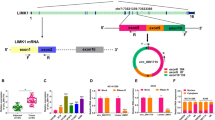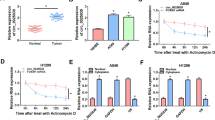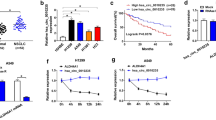Abstract
Non-small cell lung cancer (NSCLC) is a common cancer with an unfavorable 5-year survival rate. We intended to explore the role of circular RNA_0074027 (circ_0074027) in NSCLC progression. The levels of circ_0074027, messenger RNA (mRNA) of its linear form paired like homeodomain 1 (PITX1), microRNA-2467-3p (miR-2467-3p) and ras homolog family member A (RHOA) mRNA were determined by quantitative real-time polymerase chain reaction (qRT-PCR). Cell Counting Kit-8 (CCK8) assay and plate colony assay were conducted to measure the proliferation ability of NSCLC cells. Transwell assays were used to assess cell migration and invasion abilities. Flow cytometry was utilized to analyze cell apoptosis rate. Dual-luciferase reporter assay and RNA immunoprecipitation (RIP) assay were used to test the interaction between miR-2467-3p and circ_0074027 or RHOA. Western blot assay was performed to evaluate the protein level of RHOA in NSCLC cells. Murine xenograft model was built to evaluate the role of circ_0074027 in tumor growth in vivo. Circ_0074027 expression was prominently elevated in NSCLC tissues and cell lines. Circ_0074027 knockdown or miR-2467-3p overexpression suppressed cell proliferation, migration and invasion and facilitated cell apoptosis of NSCLC cells. Circ_0074027 interacted with miR-2467-3p, and RHOA was a target of miR-2467-3p in NSCLC cells. RHOA silencing blocked the malignant potential of NSCLC cells. Circ_0074027 silencing restrained the malignant phenotypes of NSCLC cells largely through up-regulating miR-2467-3p. Circ_0074027 knockdown notably blocked xenograft tumor growth in vivo. In conclusion, circ_0074027 accelerated NSCLC progression by binding to miR-2467-3p to induce RHOA expression.






Similar content being viewed by others
Data availability
The datasets used and analyzed during the current study are available from the corresponding author on reasonable request.
References
Carbone DP, Reck M, Paz-Ares L, Creelan B, Horn L, Steins M et al (2017) First-line nivolumab in stage IV or recurrent non-small-cell lung cancer. N Engl J Med 376(25):2415–2426
Chen Z, Fillmore CM, Hammerman PS, Kim CF, Wong KK (2014) Non-small-cell lung cancers: a heterogeneous set of diseases. Nat Rev Cancer 14(8):535–546
Chen T, Yang Z, Liu C, Wang L, Yang J, Chen L et al (2019) Circ_0078767 suppresses non-small-cell lung cancer by protecting RASSF1A expression via sponging miR-330-3p. Cell Prolif 52(2):e12548
Chen H, Tan X, Ding Y (2020) Knockdown SNHG20 suppresses nonsmall cell lung cancer development by repressing proliferation, migration and invasion, and inducing apoptosis by regulating miR-2467-3p/E2F3. Cancer Biother Radiopharm. https://doi.org/10.1089/cbr.2019.3430
Dong Y, Xu T, Zhong S, Wang B, Zhang H, Wang X et al (2019) Circ_0076305 regulates cisplatin resistance of non-small cell lung cancer via positively modulating STAT3 by sponging miR-296-5p. Life Sci 239:116984
Gao P, Wang Z, Hu Z, Jiao X, Yao Y (2020) Circular RNA circ_0074027 indicates a poor prognosis for NSCLC patients and modulates cell proliferation, apoptosis, and invasion via miR-185-3p mediated BRD4/MADD activation. J Cell Biochem 121(3):2632–2642
Herbst RS, Morgensztern D, Boshoff C (2018) The biology and management of non-small cell lung cancer. Nature 553(7689):446–454
Liu F, Wen C (2020) LINC01410 knockdown suppresses cervical cancer growth and invasion via targeting miR-2467-3p/VOPP1 axis. Cancer Manag Res 12:855–861
Lu XC, Zheng JY, Tang LJ, Huang BS, Li K, Tao Y et al (2015) MiR-133b Promotes neurite outgrowth by targeting RhoA expression. Cell Physiol Biochem 35(1):246–258
Memczak S, Jens M, Elefsinioti A, Torti F, Krueger J, Rybak A et al (2013) Circular RNAs are a large class of animal RNAs with regulatory potency. Nature 495(7441):333–338
Meng S, Zhou H, Feng Z, Xu Z, Tang Y, Li P et al (2017) CircRNA: functions and properties of a novel potential biomarker for cancer. Mol Cancer 16(1):94
Mizoguchi F, Murakami Y, Saito T, Miyasaka N, Kohsaka H (2013) miR-31 controls osteoclast formation and bone resorption by targeting RhoA. Arthritis Res Ther 15(5):R102
Patop IL, Wüst S, Kadener S (2019) Past, present, and future of circRNAs. EMBO J 38(16):e100836
Proto C, Ferrara R, Signorelli D, Lo Russo G, Galli G, Imbimbo M et al (2019) Choosing wisely first line immunotherapy in non-small cell lung cancer (NSCLC): what to add and what to leave out. Cancer Treat Rev 75:39–51
Qian L, Guan J, Wu Y, Wang Q (2019) Upregulated circular RNA circ_0074027 promotes glioblastoma cell growth and invasion by regulating miR-518a-5p/IL17RD signaling pathway. Biochem Biophys Res Commun 510(4):515–519
Siegel RL, Miller KD, Jemal A (2018) Cancer statistics, 2018. CA Cancer J Clin 68(1):7–30
Tian Y, Zhong L, Gao S, Yu Y, Sun D, Liu X et al (2021) LncRNA LINC00974 downregulates miR-122 to upregulate RhoA in oral squamous cell carcinoma. Cancer Biother Radiopharm 36(1):18–22
Wang J, Li H (2018) CircRNA circ_0067934 silencing inhibits the proliferation, migration and invasion of NSCLC cells and correlates with unfavorable prognosis in NSCLC. Eur Rev Med Pharmacol Sci 22(10):3053–3060
Wang YG, Wang T, Ding M, Xiang SH, Shi M, Zhai B (2019) hsa_circ_0091570 acts as a ceRNA to suppress hepatocellular cancer progression by sponging hsa-miR-1307. Cancer Lett 460:128–138
Watanabe SI, Nakagawa K, Suzuki K, Takamochi K, Ito H, Okami J et al (2017) Neoadjuvant and adjuvant therapy for Stage III non-small cell lung cancer. Jpn J Clin Oncol 47(12):1112–1118
Wu Y, Shen QW, Niu YX, Chen XY, Liu HW, Shen XY (2020) LncNORAD interference inhibits tumor growth and lung cancer cell proliferation, invasion and migration by down-regulating CXCR4 to suppress RhoA/ROCK signaling pathway. Eur Rev Med Pharmacol Sci 24(10):5446–5455
Xiao H, Liu M (2020) Circular RNA hsa_circ_0053277 promotes the development of colorectal cancer by upregulating matrix metallopeptidase 14 via miR-2467-3p sequestration. J Cell Physiol 235(3):2881–2890
Xiao J, Lai H, Wei SH, Ye ZS, Gong FS, Chen LC (2019) lncRNA HOTAIR promotes gastric cancer proliferation and metastasis via targeting miR-126 to active CXCR4 and RhoA signaling pathway. Cancer Med 8(15):6768–6779
Yu G, Wang Z, Zeng S, Liu S, Zhu C, Xu R et al (2019a) Paeoniflorin inhibits Hepatocyte Growth Factor- (HGF-) induced migration and invasion and actin rearrangement via suppression of c-met-mediated RhoA/ROCK signaling in glioblastoma. Biomed Res Int 2019:9053295
Yu X, Wang D, Wang X, Sun S, Zhang Y, Wang S et al (2019b) CXCL12/CXCR4 promotes inflammation-driven colorectal cancer progression through activation of RhoA signaling by sponging miR-133a-3p. J Exp Clin Cancer Res 38(1):32
Yu C, Ying J, Yu K, Shen W, Jiang M (2020) Circ_0074027 contributes to nonsmall cell lung cancer progression by upregulating CUL4B expression through miR-335-5p. Cancer Biother Radiopharm. https://doi.org/10.1089/cbr.2020.3579
Zhang HD, Jiang LH, Sun DW, Hou JC, Ji ZL (2018) CircRNA: a novel type of biomarker for cancer. Breast Cancer 25(1):1–7
Author information
Authors and Affiliations
Contributions
Ying Liu designed and supervised the study, Zhihui Duan conducted the experiments and drafted the manuscript. Shuqing Wei involved in methodology development and analyzed the data. All authors read and approved the final manuscript.
Corresponding author
Ethics declarations
Conflict of interest
The authors declare that they have no conflict of interest.
Ethics approval
Clinical study was approved by the Ethics Committee of Shanxi Provincial Cancer Hospital and was carried out according to the guidelines of Declaration of Helsinki. Animal experiment was permitted by the Animal Care and Use Committee of Shanxi Provincial Cancer Hospital and performed in accordance with the guidelines of the National Animal Care and Ethics Institution.
Additional information
Publisher’s note
Springer Nature remains neutral with regard to jurisdictional claims in published maps and institutional affiliations.
Supplementary Information
Supplementary Fig. 1
Circ_0074027 knockdown suppresses the EMT of NSCLC cells. (A and B) Western blot assay was employed to determine the expression of three EMT-associated markers (E-cadherin, N-cadherin and Vimentin) in A549 and H1299 cells transfected with si-NC or si-circ_0074027. **P < 0.01
Rights and permissions
About this article
Cite this article
Duan, Z., Wei, S. & Liu, Y. Circ_0074027 contributes to non‐small cell lung cancer progression through positively modulating RHOA via sequestering miR-2467-3p. J Bioenerg Biomembr 53, 223–233 (2021). https://doi.org/10.1007/s10863-021-09876-6
Received:
Accepted:
Published:
Issue Date:
DOI: https://doi.org/10.1007/s10863-021-09876-6




